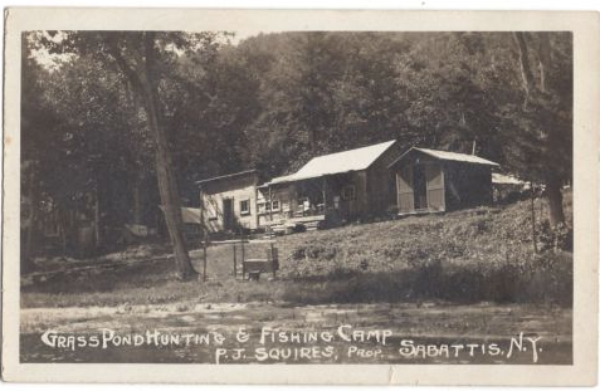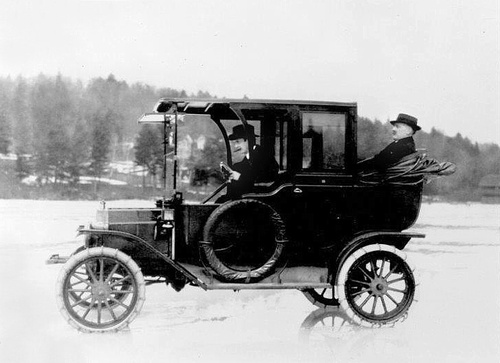 Bill Kollecker (driving) and Jay Stickney on Lower Saranac Lake.
Bill Kollecker (driving) and Jay Stickney on Lower Saranac Lake.
Courtesy of Natalie Leduc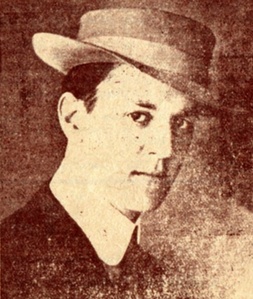 William F. Kollecker, Adirondack Enterprise, February 4, 1915
William F. Kollecker, Adirondack Enterprise, February 4, 1915 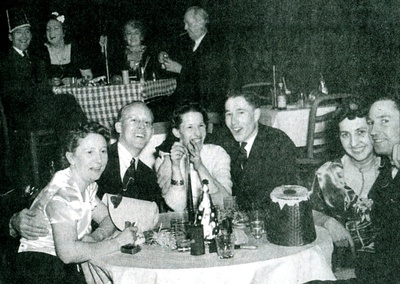 Partying on New Year's Eve, 1940. At back, center with cigar, is William Kollecker, and to his right, Charlotte Dewey. In front left are Ora and Harley Webb. If you can identify any of the others in this photograph, please use the comment box, below. Adirondack Daily Enterprise, December 29, 2012
Partying on New Year's Eve, 1940. At back, center with cigar, is William Kollecker, and to his right, Charlotte Dewey. In front left are Ora and Harley Webb. If you can identify any of the others in this photograph, please use the comment box, below. Adirondack Daily Enterprise, December 29, 2012 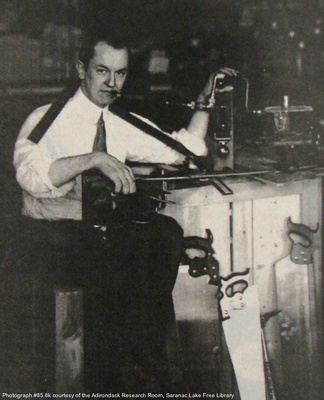 William F. Kollecker. A tongue in cheek demonstration of the tools of the framer.
William F. Kollecker. A tongue in cheek demonstration of the tools of the framer.  William F. Kollecker, in white hat, in front of Kollecker's
William F. Kollecker, in white hat, in front of Kollecker's 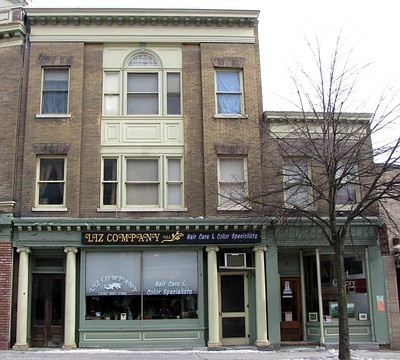 The Coulter Block, Once the home of "Kollecker Kodak and Gift Shop.
The Coulter Block, Once the home of "Kollecker Kodak and Gift Shop. 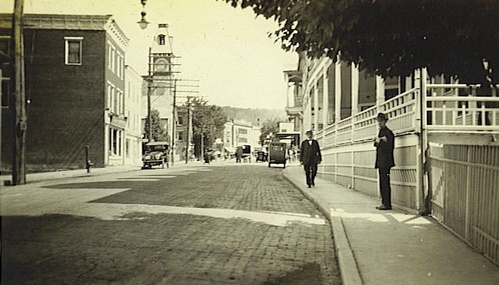 Main Street near the Riverside Inn showing the old Harrietstown Town Hall, 1920s, by William F. Kollecker.
Main Street near the Riverside Inn showing the old Harrietstown Town Hall, 1920s, by William F. Kollecker. 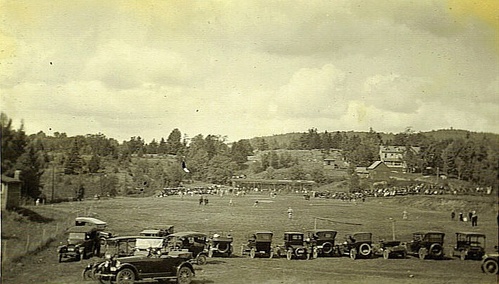 Early Saranac Lake baseball game. Photograph by William F. Kollecker Born: April 15, 1879
Early Saranac Lake baseball game. Photograph by William F. Kollecker Born: April 15, 1879
Died: August 12, 1962
Married: No
Children: None
William F. Kollecker was a photographer who, with George Baldwin, and William L. Distin, Sr., produced a rich collection of photographs of the area, that is largely preserved in the Adirondack Collection of the Saranac Lake Free Library.
Born April 15, 1878, he was the son of Jacob F. Kollecker. He left a diary of approximately twenty journals, starting from the day in January of 1896 when he left his "Papa" sitting on the steps of their Brooklyn home and took the train to Saranac Lake for health reasons, after having been employed by a Wall Street brokerage firm.
Probably around 1902-03, William Cheesman, at a Lake Placid barbershop, overheard a young man asking the barber about employment opportunities. He approached the young man and talked with him. As it turned out, the young man had photographic experience and Cheesman had a photo studio and darkroom in his store. So William F. Cheesman offered William F. Kollecker a job. Kollecker was still far from well when he began his employ at Cheesman's in Lake Placid. Under the care of Josephine Cheesman, however, he strengthened. By 1904, he was healthy enough and, thanks to his work with Mr. Cheesman, experienced enough to be ready to open his own shop and studio.
The Cheesmans, to whom the aspiring photographer had become as close as a son, loaned Kollecker $200 to get him started in a tiny storefront at 71 Main Street in Saranac Lake and on his way to becoming the most successful and prolific photographer in this village's history.
By 1921, William Cheesman had had a less than profitable experience in the Florida land market. Without Kollecker as a partner, the Cheesmans might not have been able to have purchased the Exchange and opened a shop therein. Through this transaction, Kollecker was able to help his old friends as they had helped him.
The photographer lived upstairs, where he would stay until his death in August, 1962.
Kollecker’s energy seemed limitless. Early photographic processes were tedious, time-consuming, and sometimes dangerous; yet, during Saranac Lake's Winter Carnivals, Kollecker would expose as many as 300 plates and have the prints on sale the next day. Nor was his talent and motivation limited to carnival time. No other photographer captured the face and feeling of Saranac Lake nor portrayed the lives and lifestyles of its citizens with greater accuracy or artistry for a comparable period. The people of Saranac Lake and all lovers of history and photography owe an immeasurable debt to this man.
The Kollecker Kodak and Gift Shop was a wonder to children, especially the display windows where, at Christmas, he set up the first mechanically revolving Christmas tree ever seen in the village. Kollecker loved children and he kept on hand a full series of movies of circus parades and other joys with which to entertain them.
Strangely, it was a child (unborn) that came between him and the possibility of him ever having any children of his own. It was not the baby's fault, of course, but that of a rigid morality combined with emotional vulnerability. In 1903, Kollecker was deeply in love with Hannah Clark, a sad-eyed, full-bodied beauty who taught school in Lake Placid. The following year, Hannah "came into a family way" by another man, as one who knew Kollecker put it. The photographer never spoke to his beloved schoolteacher again nor was he ever involved in another romance, although he did form a close platonic bond with at least one other woman during his later years.
When Kollecker died, he left no will, and the owners of the Coulter Block at that time had his things cleared out without ceremony. Dumptruck after dumptruck pulled up and tons of the man's legacy were shoveled out windows and pitched down the stairs. Thankfully, some of Kollecker's work had been donated to the Saranac Lake Free Library; and, also, a quick-witted passer-by intervened by paying the men a token sum to take several truckloads to his home rather than to the dump. Nevertheless, much was lost.
Original text by Philip L. Gallos
[Note: According to Susan Edelberg Donnelly, it was her father, Irving Edelberg, to whom the task fell to clear out Kollecker's apartment and shop. She writes that Kollecker "had saved every film box and scrap of paper he ever owned, magazines, etc. There was only a small path from his shop through to his apartment. Every wall was lined with boxes and film cartridge things. Inside of these many items were gold coins and money. My father and an assistant went through every leaf of a magazine and opened every box. That was the stuff that was thrown out." The rest, he donated to the Saranac Lake Free Library.] 1
Kollecker was born into a struggling family of German immigrants in Brooklyn. As a youth he worked as a messenger boy in a Wall Street brokerage firm until, at 16, he was diagnosed with tuberculosis. He was fortunate in having someone who was willing to pay a modest sum for him to be treated in Saranac Lake. He left New York city on January 21, 1896, staying first at 64 Shepard Avenue; he was five foot nine and 111 pounds. He responded well to treatment, and his doctor recommended that he stay in the area at least through the end of the summer. He worked at the Fletcher Farm in Vermontville, and later as a bellhop at the Loon Lake Hotel.
Within three years he was living in Lake Placid with the family of Charles Stickney, for whom he worked at the Lake Placid branch of the A. Fortune Company, mostly in the furniture side of the business. He bought his first camera in 1902, and became very interested in photography, and in 1903, he took a job as an assistant at Cheesman's Photography Studio in Lake Placid. He worked there for two years, learning the business, and becoming a close friend of the Cheesman family.
In 1905, with a $200 loan from Cheesman, he opened his own small shop at The Birches near the Algonquin Hotel, where he specialized producing Adirondack scenic photographic prints and postcards. Within the year, he moved to a shop at 71 Main Street. By 1908, he hired Alfred Moody as an assistant, and soon became a dealer for Kodack cameras and film. By 1911, he was doing well enough to move into larger quarters next door at 73 Main Street, and he soon took an apartment above the shop.
Kollecker's shop sold postcards and prints, as well as frames, trinkets, and knickknacks, stationery, greeting cards, and also handled film processing for amateur photographers. He also produced photos for the Adirondack Daily Enterprise, and became the official photographer for the Saranac Lake High School yearbook.
The shop became so busy that Kollecker hired a number of assistants: Hugo Franz, who handled some photo assignments; Alice Moll, who did the developing and printing; Anita Ballerano, served as sales clerk and stock person.
In his fifties, Kollecker started a relationship with Charlotte Dewey that lasted the rest of his life. Although they never married, they traveled together, and she eventually moved into a separate apartment on the same floor as his in his building.
He died at age 83. He had no known surviving relatives. His body was taken to the Fortune Funeral Home, and he was buried in the North Elba cemetery in the Cheesman family plot.
Source: Bogdan, Robert, Exposing the Wilderness: Early-Twentieth-Century Adirondack Postcard Photographers, Syracuse University Press, 1999. ISBN 0-8156-0608-7.
Adirondack Daily Enterprise, December 5, 1992
William Kollecker, photo-historian of the North Country
Like so many other former patients who regained their health in our village, William Kollecker elected to remain and establish a business. As it turned out, the decision was fortunate for all concerned. His choice of endeavor resulted in a remarkable pictorial history of Saranac Lake covering a period of slightly more than half a century from 1904 to 1962.
According to his newspaper obituary Kollecker was born in Brooklyn on April 15th, 1879, and as a young man moved over to Manhattan to work in a Wall Street brokerage house. While employed there, he fell victim to tuberculosis and immediately entrained for Saranac Lake and a date with Dr. Trudeau. He was placed in a cure cottage at Fletcher's Farm on the Upper Franklin Falls Road in 1896. Not being bedridden, he was able to perform certain duties to help out with the expenses at the cure cottage. He also worked for a while as a bell hop at the Loon Lake Hotel.
During the time he spent taking the cure, Kollecker became interested in the hobby of photography. George Eastman had made the box camera a simple and popular device some 10 years earlier and the young photographer apparently decided to record his current surroundings. He soon became quite proficient in the art and perhaps realized that he just might be able to earn a living from a pastime which he enjoyed. He knew, of course, that training and more advanced equipment would be required, so he set his sights in that direction.
When he felt that his health had been restored, he moved to Lake Placid in search of employment in his chosen field. He quickly found work in the Brownell & Kaiser Photo Shop on Main Street, where he served an apprenticeship. The Kaiser of this partnership was the same Henry J. Kaiser who later became the famous builder of liberty ships during World War II, and, after the war, the manufacturer of two short-lived automobiles, the Kaiser and the Henry J.
Kollecker next found work in the Kodak store of William Cheesman a few doors down the street from Brownell & Kaiser. This move proved to be a most important advancement in the young man's career. Mr. Cheesman took an instant liking to Kollecker and practically adopted him into the family. He taught the budding photographer all of the rudiments of developing along with the fundamental aspects of picture taking. Bill Kollecker was an adept student and as he gradually reached a level of proficiency, he decided to open his own shop. Here again Cheesman was most helpful in giving his protege a loan of $200 to get started.
Kollecker chose Saranac Lake for his entry into the photography business and in 1904 opened a small store with hopeful anticipation. He was not the first photographer in the village, as several others had been or were still in business. George Baldwin had arrived from Keeseville in the 1870s to open a shop on Main St. and captured much of the turn-of-the-century growth of the village. William Distin took over the Baldwin Studio and added art work to the photographic business. He illustrated, with pen and ink sketches, Alfred L. Donaldson's "Songs of my Violin," a book of poetry published in 1901. Another early photographer in Saranac Lake was Arthur "Bill" Allen, whose shop was at 38 Broadway, next to the bridge, in 1906. Allen apparently had a sense of humor, for his ad in the Adirondack Directory stated "If you want to see what kind of work I do, go and look at my show cases. I have to work for my living and cannot seem to exist on fresh air."
Kollecker took a more serious approach to his endeavors and began to record every activity of interest that took place in the village. He was an untiring chronicler of all such events as ball games, circus parades, building construction, holiday celebrations, and everyday street scenes. He pointed his camera at the lucky fisherman with a 25 pound lake trout and the successful nimrod with his 10 point buck. Perhaps he is best remembered for his winter carnival coverage.
Kollecker had a good sense of timely production. When the village was overflowing with visitors during carnival week, he would rush his film back to the shop where his developer, Hugo Franz, would turn out same-day photos of the various events. These sold like hot cakes! Business was booming and he soon needed larger quarters. He moved operations to his new store at 73 Main Street in 1920 and the place became a landmark for the next 42 years.
Not only the tourists but local residents as well were anxious to acquire souvenirs, not only of Winter Carnival, but also of the International Speed Skating Races that were held at the Pontiac Rink.
Photos of parade floats were in demand as were single pictures of such skaters as Ed Lamy, Charlie Jewtraw, Bobby McLean, Morris Wood, Charles Gorman, and Clas Thunberg, all world champions. Realizing that the general public also wanted to get into the act, Kollecker focused his camera on the grandstand sections that were crowded with spectators. When these results were displayed in his window, viewers gathered to spot their own image, and, if successful, a number of prints would be ordered. The cash register continued to ring with a merry sound.
Many other enterprising ventures were introduced by Kollecker who left no stone unturned. He expanded the adaptability of his many photos into such merchandise as postcards, calendars, albums, and scenic folders. Of course, there were cameras and films on the shelf as well as picture frames and porcelain novelties. He knew how to turn a buck!
As Kollecker reached the age of 50 he was a familiar figure on the village streets with his white Panama hat, his unlit cigar, and his ever-present camera. He didn't miss a single event, and his coverage of the many spectacular fires witnessed the demise of some of our best known landmarks. On the night of July 26-27 in 1926 he was awakened in the middle of the night to learn that the Town Hall was on fire. Rushing to the scene he captured the collapse of the blazing tower shortly after the faithful old town clock had struck two a.m.
In the summer of 1938, during the construction of the Lake Flower dam Kollecker and camera arrived daily at the bridge to photograph the entire project from start to finish. He was on the ground floor of the emergence of the 8 mm moving picture boom and his coverage of local events produced reel after reel of footage which today brings to life so many memories of our village affairs. This medium added new dimension to his art, for all of those Fourth of July parades, ball games, boat regattas, and winter sports could now be seen in action.
Current events also attracted Kollecker's versatile lens, and no public gathering escaped his attention. Medical gatherings at Trudeau Sanitarium, Robert Louis Stevenson Association, lawn meetings, the building of the N.V.A. Hospital, and the antics of Fresh Air Children at Camp Intermission were all recorded. The arrival of famous visitors was also covered when business and industry tycoons from nearby camps would enter the village. President Benjamin Harrison's dedication of the Saranac Lake High School was photographed by Baldwin but the summer White House occupied by President Calvin Coolidge received more than adequate coverage by Bill Kollecker in 1926. During the 1930s Kollecker made several portraits of Albert Einstein at Knollwood Club and the Einstein Cottage at Glenwood Estates. He also photographed F.D.R., Jack Shea, and Sonja Henie during the 1932 Winter Olympic Games at Lake Placid, and these photos are collectors items today.
At local election times, when the candidate's pictures would appear on the front page of the Adirondack Daily Enterprise, the credit would regularly read "Photo by Kollecker." He was also the photographer for the Saranac Lake High School yearbook the "Canaras," illustrating that publication year after year with pictures of students, faculty, and groups representing academic and sports activities.
Never a very outgoing person, Kollecker became almost taciturn in his late years. Behind the counter in his store, where the Saranac Lake Jewelry Store is presently located, he was often terse with his customers and did not indulge in superfluous conversation. He was not socially inclined and his personal friendships were limited to a choice few. It was not certain whether or not he once smoked, but he would cut each cigar in half and chew on the unlit stub until replacing it with the other half.
Two of his long-time companions were Charlotte Dewey, who maintained a small religious shop next door to Kollecker's, and Richard Longtin who was president of the Paul Smith's Electric Co. The trio could frequently be seen having lunch at the Hotel Saranac.
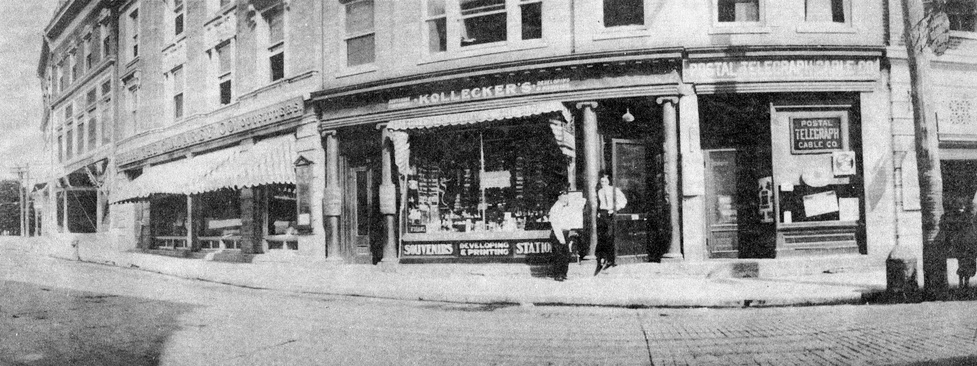 Adirondack Daily Enterprise, December 5, 1992
Adirondack Daily Enterprise, December 5, 1992
William F. Kollecker died in his Main St. apartment on August 22nd, 1962. His career straddled the age of photography from heavy glass plate negatives to the arrival of the flexible cellulose film, from moving pictures to the coming of technicolor. The Saranac Lake Free Library acquired a large amount of his glass plate negatives which have been converted to prints that can be viewed in the library's Adirondack Room today.
Chateaugay Record, July 2, 1926
Brewster Guests See Themselves on Screen.
Mr. and Mrs. Jesse' G. Brewster entertained a number of their friends in an unusual manner at their home last Friday evening. Mr. Kollecker, of Saranac Lake, who spent some time in Florida, this winter taking moving pictures, showed scenes in which some of the guests present appeared as characters on the screen which made it most interesting. After the movies the guests were conveyed to the Country Club where refreshments were served.
The guests of honor were Mr. and Mrs. Edward J. Nolan, of Chateaugay, who had been spending their honeymoon in Lake Placid. A decorated cake, topped with a miniature bride and groom, was presented to them. William Dwyer acted as toastmaster and Supervisor Wells offered some advice as to the best roads to happiness.
Others present were: Mrs. B. R. Brewster, Miss Charlotte Dewey, Miss Margaret Hogan, W. F. Cheeseman and son Cleon, Mrs. William Dwyer, Mr. and Mrs. R. D. Wells, Mrs. Willis Wells, Mr. and Mrs. Jack Thornton, Mr. and Mrs. William Hovey, Mr. and Mrs. Neil Carey, Mr. and Mrs. Scott North and Mr. and Mrs. G. Kelleher.—Lake Placid News
May 23, 2015 on Ebay a Kollecker Postcard sold for $102.50.
External links
- The Adirondack Experience has a collection of at least 180 Kollecker Photographs
- 46 Kollecker photographs from the Adirondack Research Room, Saranac Lake Free Library, at the Northern New York Library Network
Footnotes
1. Letter from Susan Edelberg Donnelly to Historic Saranac Lake, October 26, 2007


